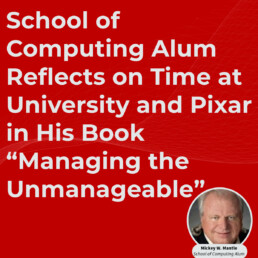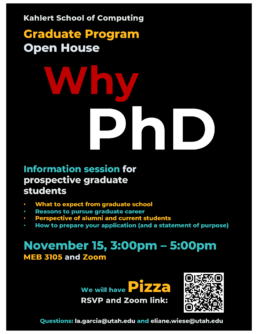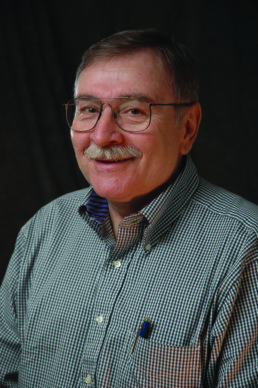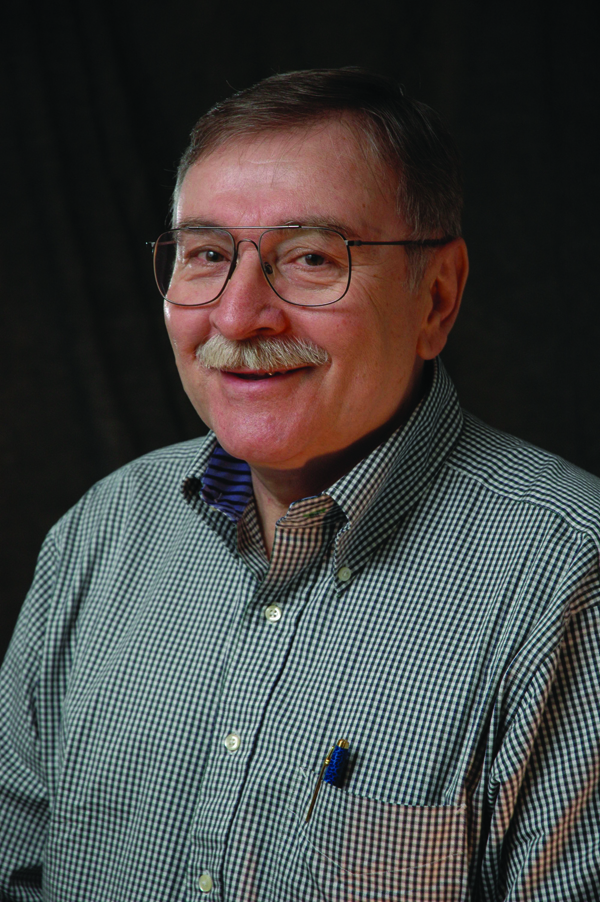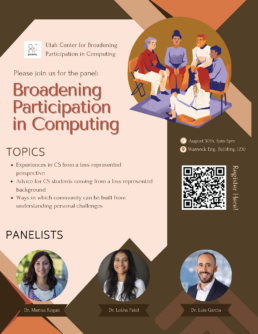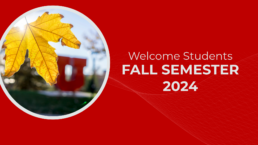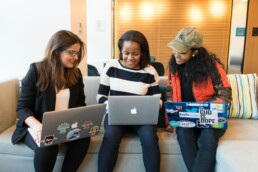School of Computing Alum Reflects on Time at University and Pixar in His Book “Managing the Unmanageable”
From the Cradle of Computer Graphics at the University of Utah to Pixar Animation Studios, my 50+ year professional career has been a parabola of many groundbreaking projects, as well as startup companies—some that have become household names, including Brøderbund Software, Gracenote/SONY, and others. It has been an exciting and rewarding journey not only because of the bleeding edge technology and innovative products I worked on, but also due to the privilege of working with, managing, and leading people in these companies. I reflect on part of this journey in this article and my book “Managing The Unmanageable”.
RSVP to the Grad Program Open House: Why PhD
Ever wondered what it's really like to be a graduate student—or why anyone would take the plunge to do a PhD? Join us for the Kahlert School of Computing’s Graduate Program Open House!
We’ll cover the "whys" of grad school with real insights from alumni, current students, and faculty to help you decide if a PhD is right for you. Plus, we’ll share tips on putting together a strong application.
We’ll be meeting on November 15 from 3–5 PM in MEB 3105 or online via Zoom—and yes, there’ll be pizza!
Use this link to RSVP: https://forms.gle/Sbkb2fnovw81awTs7
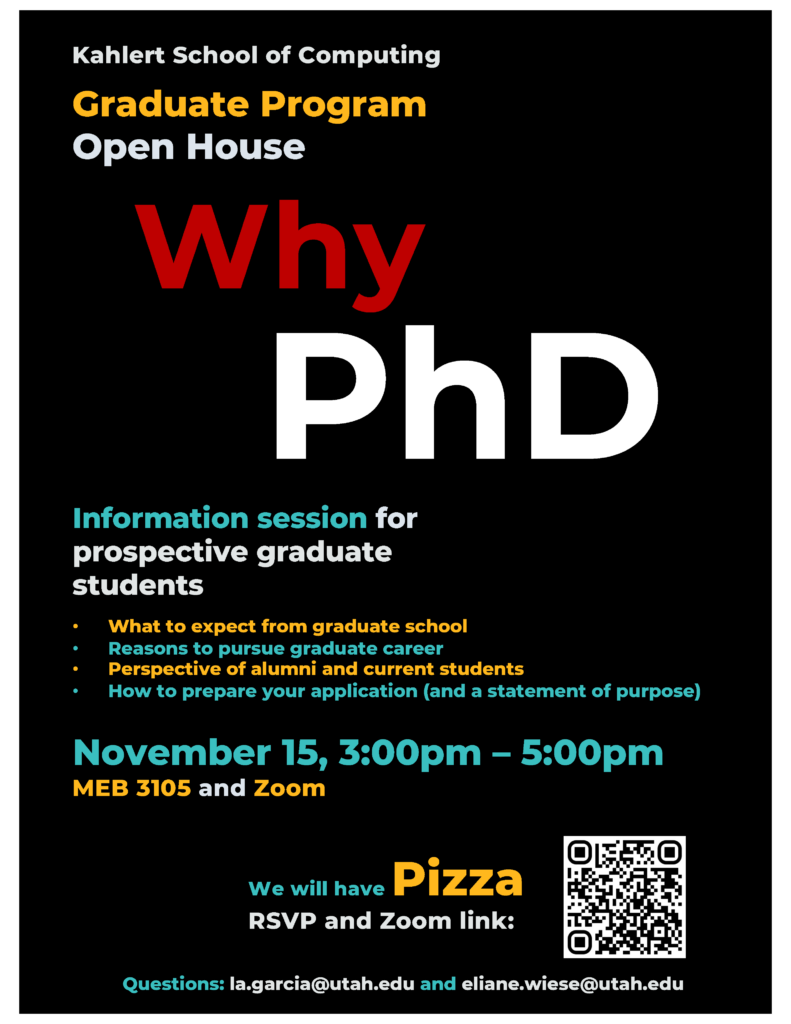
Remembering Frank Stenger
Frank Stenger, a Kahlert School of Computing emeritus faculty member, passed away on October 23, 2024. Frank joined the Department of Computer Science at Utah in 1989 and retired from the School of Computing in 2008.
Frank spent 20 years teaching and conducting research in the School of Computing, prior to joining the School he spent 20 years as a professor in the Department of Mathematics here at the University of Utah. He received an undergraduate degree in engineering at the University of Alberta (Engineering--Physics, with emphasis on Electrical Engineering), continuing at the University of Alberta he received Masters degrees in Electrical Engineering (Servomechanisms) and in Mathematics (Numerical Analysis), and a Ph.D. in Mathematics (Computational Asymptotics).
During his lifelong career, he produced a large body of original research in the development of algorithms, in areas “less traveled on” by other researchers, such as computational approximation, solution of nonlinear equations, Sinc methods; these yield novel methods for solving partial differential and integral equations. He also developed algorithms for non-destructive viewing of a part of a human being, and for determining whether the vote count at a voting center is fraudulent. He was an extremely productive scholar, publishing more than 200 papers and multiple books. Frank also lectured in over 20 different countries.
Frank was born in Hungary, and after WWII, he lived in East Germany, then in West Germany, then in Canada, finally landing in the United States after completion of his course studies.
There will be a celebration of Frank’s life on November 23, 2024.
Kahlert Researchers Join ARPA-H Project to Develop Fully Automated Surgical Robot
Kahlert Researchers Join ARPA-H Project to Develop Fully Automated Surgical Robot
Organick 2024
Thursday, October 24, 2024
The Robert H. and Katharine B. Garff Building Auditorium; University of Utah
1731 East Campus Center Drive, SLC, Utah 84112
5:45pm: Refreshments
6:00pm: Lecture
Alexei A. Efros
UC Berkeley professor, University of Utah alumnus
We Are (Still!) Not Giving Data Enough Credit
Synopsis: For most of its existence, Visual Computing has been primarily focused on algorithms, with data treated largely as an afterthought. Only recently, with the advances in AI, did our field start to truly appreciate the singularly crucial role played by data, but even now we might still be underestimating it. In this talk, I will begin with some historical examples illustrating the importance of large visual data for both human and computer vision. I will then share some of our recent work demonstrating the power of very simple algorithms when used with the right data, including visual in-context learning and visual data attribution.
Transit and Parking Information:
LECTURE IN GARFF AUDITORIUM
The Robert H. and Katharine B. Garff Building
1731 East Campus Center Drive, SLC, Utah 84112
PUBLIC TRANSIT: Ride UTA Trip Planner
PARKING IN THE CENTRAL CAMPUS GARAGE: Please park in any unmarked stall on the second level (P2). Tickets will be given if you park anywhere but (P2).
The (P2) column color is BLACK.
Click the linked image below for a map or click here for Google Maps location.
*From the birds-eye view from above, the Central Campus Garage is under the soccer field.
Friday, October 25, 2024
Finding Joy in Research (Town Hall format)
1:00pm Refreshments and Lecture
Warnock Engineering Building, Room 1230
Lecturer Bio
- Alexei (Alyosha) Efros is a professor of Electrical Engineering and Computer Science at UC Berkeley. His research is in the area of visual computing and machine learning. He is particularly interested in using data-driven techniques to tackle problems where large quantities of unlabeled visual data are readily available.
- Efros received his B.S. (summa cum laude) in Computer Science from the University of Utah in 1997, and PhD from UC Berkeley in 2003. He did a post-doc at the University of Oxford and then spent a decade on the faculty of Carnegie Mellon University before joining Berkeley.
- He is a recipient of CVPR Best Paper Award (2006), Sloan Fellowship (2008), Guggenheim Fellowship (2008), SIGGRAPH Significant New Researcher Award (2010), three PAMI Helmholtz Test-of-Time Prizes (1999,2003,2005), the ACM Prize in Computing (2016), Diane McEntyre Award for Excel- lence in Teaching Computer Science (2019), Jim and Donna Gray Award for Excellence in Undergraduate Teaching of Computer Science (2023), and PAMI Thomas S. Huang Memorial Prize (2023).
There will be a private reception and dinner (for guests 21 and older) after the lecture for industry partners and faculty. $600 for tables of 8; and $100 per individual ticket. Please contact Sheri Carp at sheri@cs.utah.edu to secure your reservation.

Kahlert School of Computing Faculty Pavel Panchekha and Ganesh Gopalakrishnan Receive NSF Grant Valued at Over $1M
Assistant Professor Pavel Panchekha and Professor Ganesh Gopalakrishnan have received a multi-institutional Community Infrastructure for Research in Computer and Information Science and Engineering (CIRC) grant from the National Science Foundation (NSF) for a research project expected to improve real-world numerical software packages by allowing them to operate faster and more reliably across platforms.
The collaborative research project, “Workbench for Reliable and Efficient Numerics”, has received a continuing grant valued at $1,998,953 ($1,158,953 for Utah; the collaborating efforts are lead by Professors Cindy Rubio-González at the University of California Davis and Zachary Tatlock at the University of Washington). This will allow Panchekha and Gopalakrishnan as Principal and Co-Principal Investigators to create a workbench for scientists and engineers to better address numerical issues in their day-to-day work.
“Numerical issues are issues caused by the gap between mathematical (real) numbers and the number representations used on computers, like floating point. Ultimately, this gap makes it difficult for scientists and engineers to develop software that does numerical computation accurately and runs reliably and efficiently on a variety of hardware and software platforms,” states the project abstract. “Over the years, the research community has studied these issues and developed a number of tools that make developing numerical software easier, but these tools have become difficult to use together.”
The project builds on existing FPBench standardization and interoperability efforts to address the complexities of real-world numerical workflows. The outcomes of this research project are expected to simplify this process for national laboratories, industry members, and academics alike, as well as build community between these sectors through initiatives such as community meetings, workshops, and Research Experiences for Undergraduates (REUs).
Numerical computing is behind scientific simulations, engineering calculations, and financial models. It's also at the core of high-tech advances like artificial intelligence. "We're always demanding that our programs are faster, more capable, and more reliable. There are really exciting advances in the last few years in how we do that for numerical programs, and this grant is about taking those advances and putting them, via newly designed tooling, in the hands of users," said Prof. Panchekha. He plans to build on his experience working with scientists at national labs and researchers in industry to make numerical work easier. "It's all about bringing software, and the researchers behind it, together to make something people can use," he added.
To view the full award abstract from NSF.gov, click here.
Register for UCBPC's Broadening Participation in Computing panel on August 30
Join the Utah Center for Broadening Participation in Computing on August 30 at 4 p.m. in Warnock Engineering Building (WEB) room 1230.
Dr. Marina Kogan, Dr. Lekha Patel, and Dr. Luis Garcia will be discussing experience in CS from a less-represented perspective, advice for CS students coming from a less represented background, and ways in which community can be built from understanding personal challenges.
The registration form can be found here.

Fall Semester 2024
Welcome back, students! We're looking forward to a new year of innovation and discovery with you all. Have a great first week of the semester 📚🎓💡
The U Collaborates with Tulane on up to $23 Million Cancer Moonshot Project to Build Advanced Tumor Imaging System
The U Collaborates with Tulane on up to $23 Million Cancer Moonshot Project to Build Advanced Tumor Imaging System
New Approach to Teaching User Experience Design Skills Wins Award
A team of researchers at the Kahlert School of Computing has won a best paper honorable mention award for their paper describing a new approach to teaching students about design empathy in the classroom. The award-winning paper will be presented at the Designing Interactive Systems (DIS) 2024 conference taking place this week in Copenhagen, Denmark.
When software companies like Apple, Google, and Microsoft create or improve applications they start by doing lots of work to better understand their users. User experience researchers collect data: they observe, interview, survey, and study potential users so that they can understand how the software might fit into their lives, also known as developing “design empathy” for those potential users. Having design empathy is valuable even to other people on the software teams who are not designers – software engineers and project managers make better software when they understand more about who is using it and how it will be used.
This is even more crucial when people are creating software for people whose lives are very different from their own: for example, when someone who does not have a disability is designing software that will be used by people who do have disabilities, as is often the case. However, teaching students about design empathy is a difficult challenge for professors: collecting this data is itself a skill, and it requires the participation of other third parties to serve as “the users.” Again, when working with a population of users with disabilities, this can be a particular challenge.
Newly graduated doctoral students Tamanna Motahar and Noelle Brown, along with their advisors Professors Eliane Stampfer Wiese and Jason Wiese, developed a new approach to more effectively teach design empathy in the classroom. The approach leverages the fact that many people post publicly about their experiences on social media platforms such as Reddit. The team first collected some of these posts for a particular user community: people who have had a spinal cord injury. They categorized each post based on its subject, and then used those categories to guide the creation of fictional design scenarios: going to the grocery store, going on vacation, returning to school after an injury, and handling air travel.


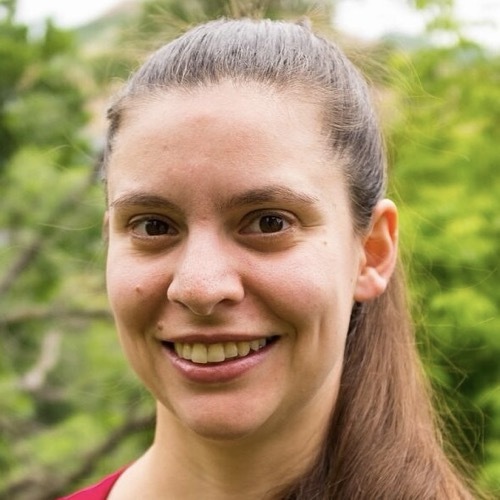
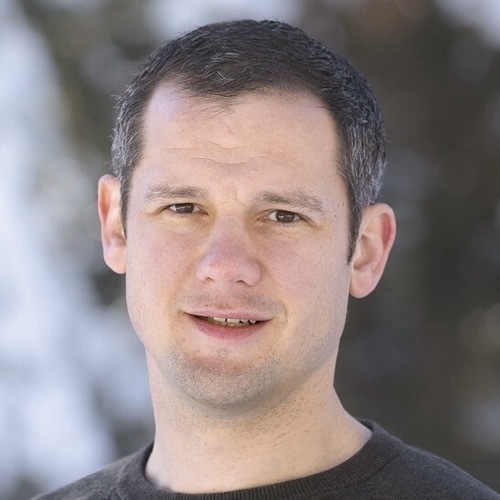
They then selected some of the posts, paraphrased or changed their wording to protect the identity and privacy of the original poster, and curated the posts into a reading assignment that would accompany each scenario. Finally, they wrote a multi-part assignment around these scenarios and posts. In part 1, students are each assigned to think through one of the design scenarios using a series of questions to prompt their thinking. Part 2 involves reading the curated and paraphrased posts, described above. In part 3 the students come together in class with groups of 3-4 students who were assigned different scenarios to discuss their thoughts after reading the posts. In part 4, the students revisit their individual design scenarios from part 1 to see if they would add or change anything.
To test the idea, the team deployed the project in a small class that Professor Jason Wiese was teaching. “What we saw was that despite the students providing thoughtful responses to the design prompt in part 1, their in-class conversations and final responses in part 4 showed that their perspective really shifted and they considered the impact of many more real-world factors after reading the posts,” said Motahar, the lead author of the paper.
The research team plans to further refine the assignment and to work towards sharing the assignment materials more broadly, so that other teachers can use them to teach students about developing design empathy. One important consideration in this work, and especially about sharing the assignment materials, is about the ethical implications of using social media posts for a purpose other than what was originally intended by the poster, and also to protect the privacy of those posters. The research team followed broadly agreed upon best practices for working with such social media data, including removing any identifiers - including usernames or locations - and changing the words of the posts before using them while still preserving the meaning of the original post.
The full paper is available online: Tamanna Motahar, Noelle Brown, Eliane Stampfer Wiese, and Jason Wiese. Toward Building Design Empathy for People with Disabilities Using Social Media Data: A New Approach for Novice Designers. In Designing Interactive Systems Conference (DIS '24). https://doi.org/10.1145/3643834.3660687

